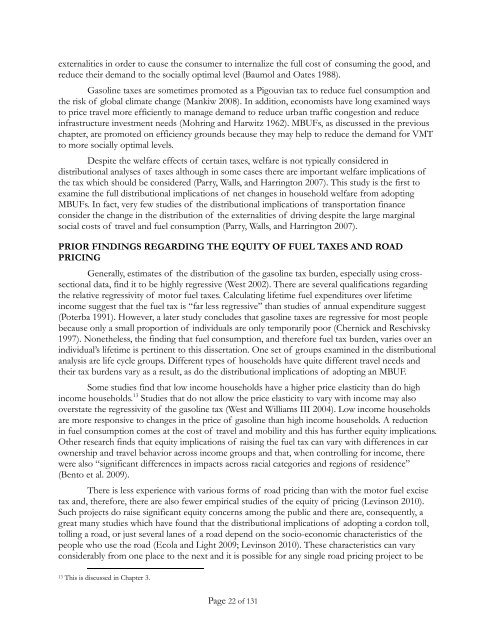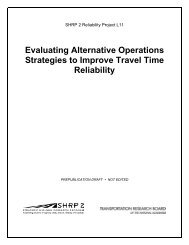Mileage-Based User Fee Winners and Losers - RAND Corporation
Mileage-Based User Fee Winners and Losers - RAND Corporation
Mileage-Based User Fee Winners and Losers - RAND Corporation
Create successful ePaper yourself
Turn your PDF publications into a flip-book with our unique Google optimized e-Paper software.
externalities in order to cause the consumer to internalize the full cost of consuming the good, <strong>and</strong><br />
reduce their dem<strong>and</strong> to the socially optimal level (Baumol <strong>and</strong> Oates 1988).<br />
Gasoline taxes are sometimes promoted as a Pigouvian tax to reduce fuel consumption <strong>and</strong><br />
the risk of global climate change (Mankiw 2008). In addition, economists have long examined ways<br />
to price travel more efficiently to manage dem<strong>and</strong> to reduce urban traffic congestion <strong>and</strong> reduce<br />
infrastructure investment needs (Mohring <strong>and</strong> Harwitz 1962). MBUFs, as discussed in the previous<br />
chapter, are promoted on efficiency grounds because they may help to reduce the dem<strong>and</strong> for VMT<br />
to more socially optimal levels.<br />
Despite the welfare effects of certain taxes, welfare is not typically considered in<br />
distributional analyses of taxes although in some cases there are important welfare implications of<br />
the tax which should be considered (Parry, Walls, <strong>and</strong> Harrington 2007). This study is the first to<br />
examine the full distributional implications of net changes in household welfare from adopting<br />
MBUFs. In fact, very few studies of the distributional implications of transportation finance<br />
consider the change in the distribution of the externalities of driving despite the large marginal<br />
social costs of travel <strong>and</strong> fuel consumption (Parry, Walls, <strong>and</strong> Harrington 2007).<br />
PRIOR FINDINGS REGARDING THE EQUITY OF FUEL TAXES AND ROAD<br />
PRICING<br />
Generally, estimates of the distribution of the gasoline tax burden, especially using crosssectional<br />
data, find it to be highly regressive (West 2002). There are several qualifications regarding<br />
the relative regressivity of motor fuel taxes. Calculating lifetime fuel expenditures over lifetime<br />
income suggest that the fuel tax is “far less regressive” than studies of annual expenditure suggest<br />
(Poterba 1991). However, a later study concludes that gasoline taxes are regressive for most people<br />
because only a small proportion of individuals are only temporarily poor (Chernick <strong>and</strong> Reschivsky<br />
1997). Nonetheless, the finding that fuel consumption, <strong>and</strong> therefore fuel tax burden, varies over an<br />
individual’s lifetime is pertinent to this dissertation. One set of groups examined in the distributional<br />
analysis are life cycle groups. Different types of households have quite different travel needs <strong>and</strong><br />
their tax burdens vary as a result, as do the distributional implications of adopting an MBUF.<br />
Some studies find that low income households have a higher price elasticity than do high<br />
income households. 13 Studies that do not allow the price elasticity to vary with income may also<br />
overstate the regressivity of the gasoline tax (West <strong>and</strong> Williams III 2004). Low income households<br />
are more responsive to changes in the price of gasoline than high income households. A reduction<br />
in fuel consumption comes at the cost of travel <strong>and</strong> mobility <strong>and</strong> this has further equity implications.<br />
Other research finds that equity implications of raising the fuel tax can vary with differences in car<br />
ownership <strong>and</strong> travel behavior across income groups <strong>and</strong> that, when controlling for income, there<br />
were also “significant differences in impacts across racial categories <strong>and</strong> regions of residence”<br />
(Bento et al. 2009).<br />
There is less experience with various forms of road pricing than with the motor fuel excise<br />
tax <strong>and</strong>, therefore, there are also fewer empirical studies of the equity of pricing (Levinson 2010).<br />
Such projects do raise significant equity concerns among the public <strong>and</strong> there are, consequently, a<br />
great many studies which have found that the distributional implications of adopting a cordon toll,<br />
tolling a road, or just several lanes of a road depend on the socio-economic characteristics of the<br />
people who use the road (Ecola <strong>and</strong> Light 2009; Levinson 2010). These characteristics can vary<br />
considerably from one place to the next <strong>and</strong> it is possible for any single road pricing project to be<br />
13 This is discussed in Chapter 3.<br />
Page 22 of 131















